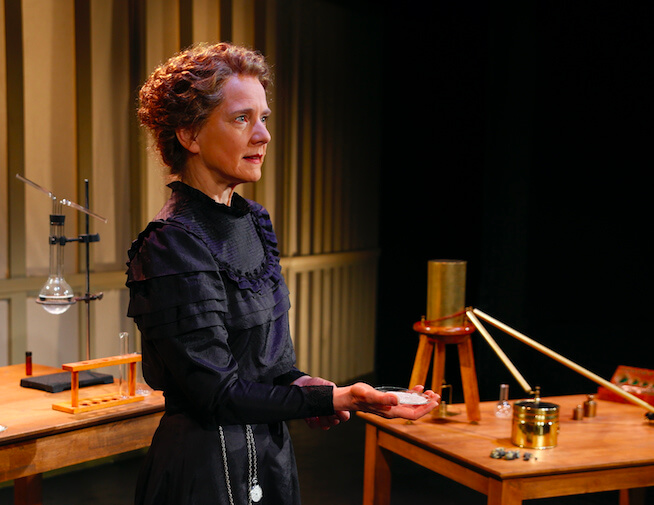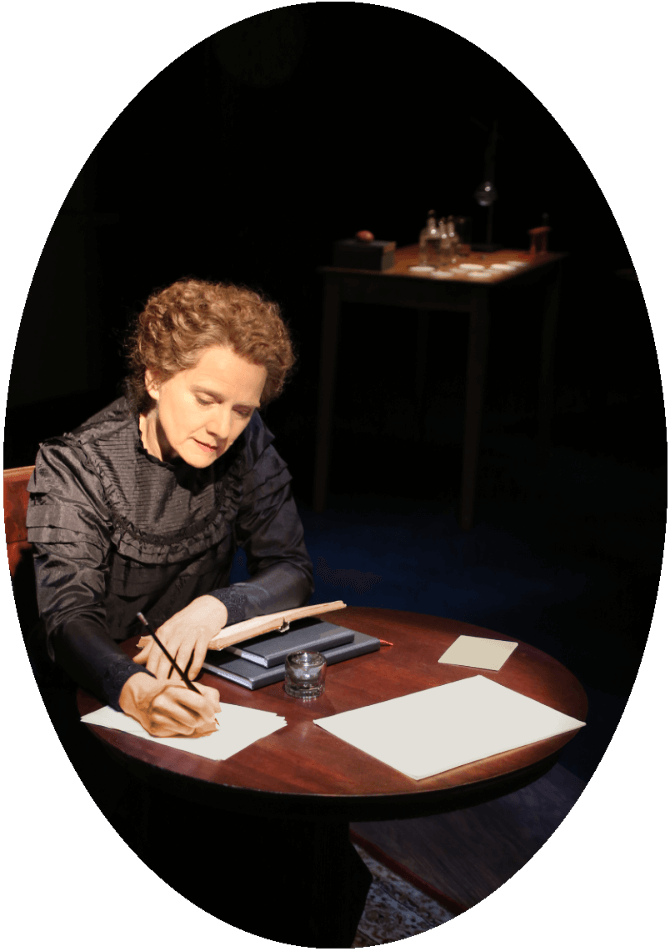Manya
The Living History
of Marie Curie
Program Description

Likely the most famous woman scientist, Madame Marie Curie (née Maria Skłodowska) — changed the world in which we live through her discovery of radium and radioactivity. Through collaboration with the medical community the Curies discovered and established the first successful radiation treatments of cancer. Simply through her own passion and perseverance, Marie Curie opened the doors of science to women world wide.
This program honors a preeminent woman of science : Madame Curie was the first European woman to earn a doctorate in physics; the first woman to receive a Nobel Prize (for the discovery of radioactivity); the first woman to teach at the Sorbonne; and the first person to receive a second Nobel Prize (a feat not to be repeated for another half century). Audiences witness the origins of scientific discoveries we now take for granted. They re-live the remarkable collaboration between husband and wife, Pierre and Marie, companion scientists.
This program honors the ethic of scientific altruism. Einstein said Marie Curie was "the only person to be uncorrupted by fame." In today's age of patents and litigation, the audience learns that the Curies declined to patent their methods, refused to bend their discoveries toward personal financial gain. Marie insisted that to profit from the discovery of radium would be "contrary to the scientific spirit."
This program honors the wife and mother, who felt more daunted by the chemistry of the kitchen than of the laboratory. As a single mother, Marie raised her two daughters from ages 16 months and 8 years, after the tragic death of her husband, Pierre. And it honors Manya's Polish heritage — much neglected not only now, but in her own life, to her own dismay. This program brings to light many of Marie's lesser-known contributions, both social and scientific — and the obstacles she faced along the way.
Marie Curie was, in turn, nervous and shy in public, obsessive about measurement, in denial of the dangers of working with radioactive materials, proud and possessive of her discoveries, yet generous to the extreme with the products of her work. Within her lifetime she saw the curative effects of radiation on cancer. Late in life she came to admit the dangers of working with radioactive materials. She died before the new understanding of the atom — initiated by her discoveries — produced the atomic bomb. Whether looking at Marie within her historical context or through the lens of a new millennium, this is a life that challenges our assumptions about what one person can achieve and the responsibilities of science.

Two program lengths available:
- MANYA - A Living History of Marie Curie. Two-hour (with intermission) program for adults or young adults. The year is 1915. Wrapped in a context of the outset of the Great War, this program spans childhood memories, romance, scientific discoveries, honors, the disruptions incurred by fame, the pain of loss of her husband, and emergence.
- A Visit with Madame Curie. One-hour Chautauqua-format program with content adjusted for adults or for school groups grades 4 through 12. A 40 to 45-minute presentation from childhood through scientific discovery, followed by a 10 minute Q&A with Marie Curie, and a 10 minute Q&A with the author/presenter.
Detailed Comparison of the two programs:
Both programs start with childhood memories that include Maria's dawning interest in science and her determination to conquer obstacles to obtaining an education in politically oppressed Poland - where women were not allowed to obtain schooling after gymnasium (high school). Both programs trace her migration to the Sorbonne, her unconventional romance with Pierre Curie, the birth of their first daughter, and the basis of Marie's scientific investigations that led to the discovery of two new elements (polonium and radium), pioneering research in radioactivity, and the use of radium therapy against cancer.
The full-length program covers the above topics more richly, painting multiple layers that are revealed again later in her life. It then goes on to describe the winning of the Nobel Prizes and other honors, the birth of their second daughter, the disruptions incurred by fame, the untimely death of Pierre, Marie's emergence into the spotlight as the first woman to teach at the Sorbonne, her education of her daughters, and receipt of the second Nobel Prize. Furthermore, the full-length program is wrapped in the historical context of the outset of the Great War (World War I).
The shorter program presents about a third of the material of the full-length program. The Q&A periods in the one-hour program allow the audience to selectively learn more. At the end of the one-hour program, the audience has met Marie Skłodowska-Curie. At the end of the full-length program, they know her.
Downloadable documents: